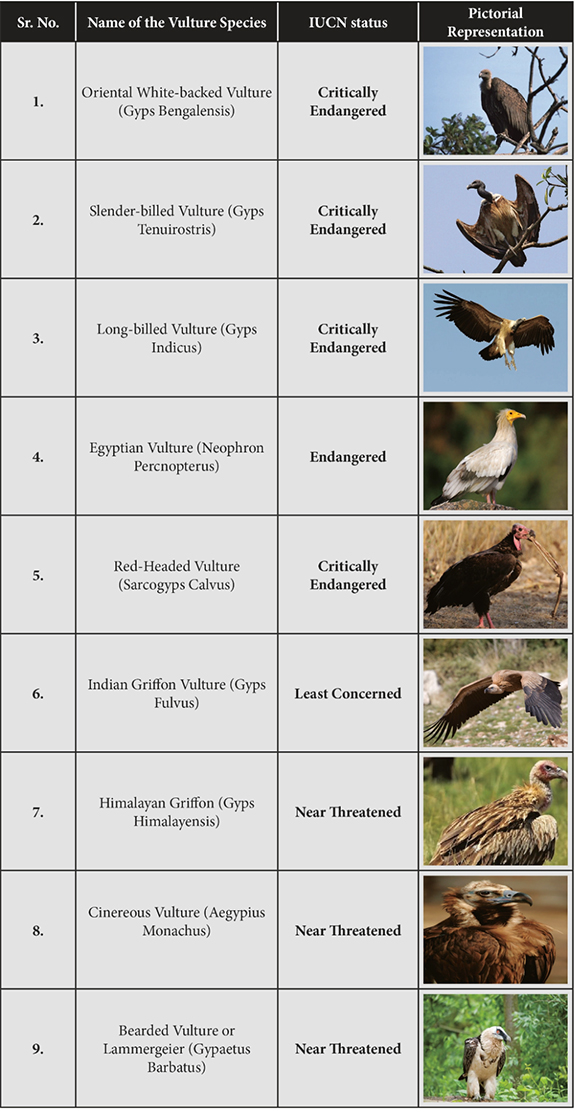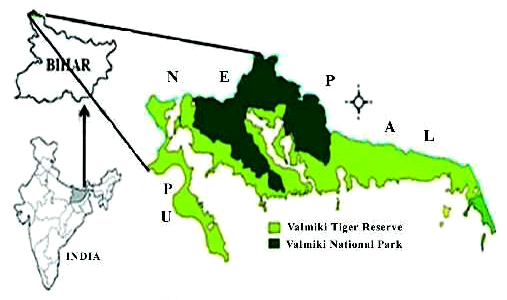Biodiversity & Environment
Conservation of Vultures
- 03 Jul 2021
- 4 min read
Why in News
Recently, 150 vultures were seen in the Valmiki Tiger Reserve (VTR), Bihar, which has prompted a vulture conservation plan in the protected region of VTR.
Key Points
- About Vultures:
- It is one of the 22 species of large carrion-eating birds that live predominantly in the tropics and subtropics.
- They act an important function as nature’s garbage collectors and help to keep the environment clean of waste.
- Vultures also play a valuable role in keeping wildlife diseases in check.
- India is home to 9 species of Vulture namely the Oriental white-backed, Long-billed, Slender-billed, Himalayan, Red-headed, Egyptian, Bearded, Cinereous and the Eurasian Griffon.
- Most of these 9 species face danger of extinction.
- Bearded, Long-billed, Slender-billed, Oriental white-backed are protected in the Schedule-1 of the Wildlife Protection Act 1972. Rest are protected under ‘Schedule IV’.
- IUCN status:
- Threats:
- Poisoning from diclofenac that is used as a medicine for livestock.
- Loss of Natural Habitats due to anthropogenic activities.
- Food Dearth and Contaminated Food.
- Electrocution by Power lines.
- Conservation Efforts:
- Recently, the Ministry for Environment, Forests and Climate Change launched a Vulture Action Plan 2020-25 for the conservation of vultures in the country.
- It will ensure minimum use of Diclofenac and prevent the poisoning of the principal food of vultures, the cattle carcasses.
- The Vulture Safe Zone programme is being implemented at eight different places in the country where there were extant populations of vultures, including two in Uttar Pradesh.
- To upscaling conservation four rescue centres will be opened like Pinjore in the north, Bhopal in central India, Guwahati in Northeast and Hyderabad in South India.
- The ministry has now also launched conservation plans for the red-headed and Egyptian vultures, with breeding programmes for both.
- To study the cause of deaths of vultures in India, a Vulture Care Centre (VCC) was set up at Pinjore, Haryana in 2001.
- Later in 2004, the VCC was upgraded to being the first Vulture Conservation and Breeding Centre (VCBC) in India.
- At present, there are nine Vulture Conservation and Breeding Centres (VCBC) in India, of which three are directly administered by the Bombay Natural History Society (BNHS).
- Recently, the Ministry for Environment, Forests and Climate Change launched a Vulture Action Plan 2020-25 for the conservation of vultures in the country.
Valmiki Tiger Reserve
- Location:
- located at the India-Nepal border in the West Champaran district of Bihar.
- It forms the easternmost limits of the Himalayan Terai forests in India.
- Situated in the Gangetic Plains bio-geographic zone of the country, the forest has a combination of bhabar and terai tracts.
- Establishment:
- This was established in March 1994 under Project Tiger.
- Biodiversity:
- The wildlife found in the forest of National Park are the Bengal tiger, Indian rhinoceros, black bear, Indian sloth bear, otter, Indian leopard, wild dog, buffalo, and boar.
- Also Indian flying foxes can be sighted here.
- The Reserve has rich avifauna diversity. Over 250 species of birds have been reported.
- Tharu’, a scheduled tribe, is the dominant community in the landscape of the Valmiki National Park.
- Other Protected Areas in Bihar:
- Bhimbandh Sanctuary.
- Rajgir Sanctuary.
- Kaimur Sanctuary.
- Kanwar Jheel Bird Sanctuary.
- Vikramshila Gangetic Dolphin.
- Gautambudha Sanctuary.






